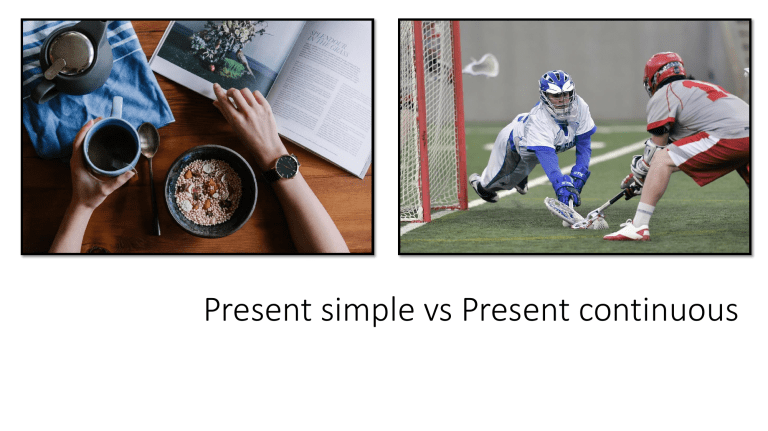
Present simple vs Present continuous Present Simple We use the present simple to express facts or truths. He works as a doctor. Present Simple We use the present simple to talk about habits or routines. We usually watch T. V. at night. Present Simple We use the present simple to express schedules or programs. The train leaves at 10 p. m. Present Simple We use the present simple to instruct. Open the window. Present Continuous We use the present continuous for actions that are happening now, at or around the time of speaking. She is sleeping at the moment. Choose the correct tense. Exercise 1 Example: We ____ some French homework every day. (do) We do some French homework every day. 1. I _____ on the chair now. (sit) I am sitting on the chair now. 2. My parents _________ to do shopping every Saturday. (go) My parents don´t go to do shopping every Saturday. 3. Vince _________ to the radio now. (listen) Vince is listening to the radio now. Present Continuous We form the present continuous with the verb to be and the main verb + ing. They are dancing. Use 1 We use the present continuous for actions that are happening now, at or around the time of speaking. She is mopping the floor now. Use 2 We use the present continuous for actions happening around the moment of speaking. Mary is studying hard this week. Use 3 We use the present continuous for fixed arrangements in the near future. They´ re having a party tonight. Exercise 1 Write some sentences using present continuous using your own ideas. Negative Form We form the negative form of the present continuous with the subject + verb to be + not + main verb in –ing form. I ´m amnot noteating eatinghealthy. healty. Questions The verb to be goes before the subject in questions. Is heis riding a horse ? He What time of the year is it? Where is she? What is she doing? What is she feeling? Exercise 2 Respond the questions given. What kind of clothes is she wearing? What time of the year is it? Where are they? What are they doing? What kind of clothes are they wearing? What are they feeling? What time of the year is it? Where are they? What are they doing? What are they feeling? What kind of clothes are they wearing? Exercise 3 Example: I am dancing. Am I dancing? 1. She is painting a body. Is she painting a body? 2. Karla and Luis are having dinner. Are Karla and Luis having dinner? 3. Monica is playing the sax. Is Monica playing the sax? Change the affirmative statements to questions. State Verbs A state is when something stays the same. An action is when something happens. State verbs are not usually used in any continuous form. State verbs: •senses: appear, hear, look like, see, taste •feeling: like, hate, love, prefer, want, wish •thinking: agree, believe, forget, know, think, understand •possession: belong to, contain, have, own •being: be, exist •other: cost, depend on, mean, need •Some of the verbs in the previous list can have a ‘state’ meaning and an ‘action’ meaning: - be, have, taste, think. I have two sisters. (permanent state ) I’m having problems with this TV-set. (temporary action ) Sometimes state verbs can describe temporary feelings. How are you getting on at your new school? I hate / I’m hating it!




